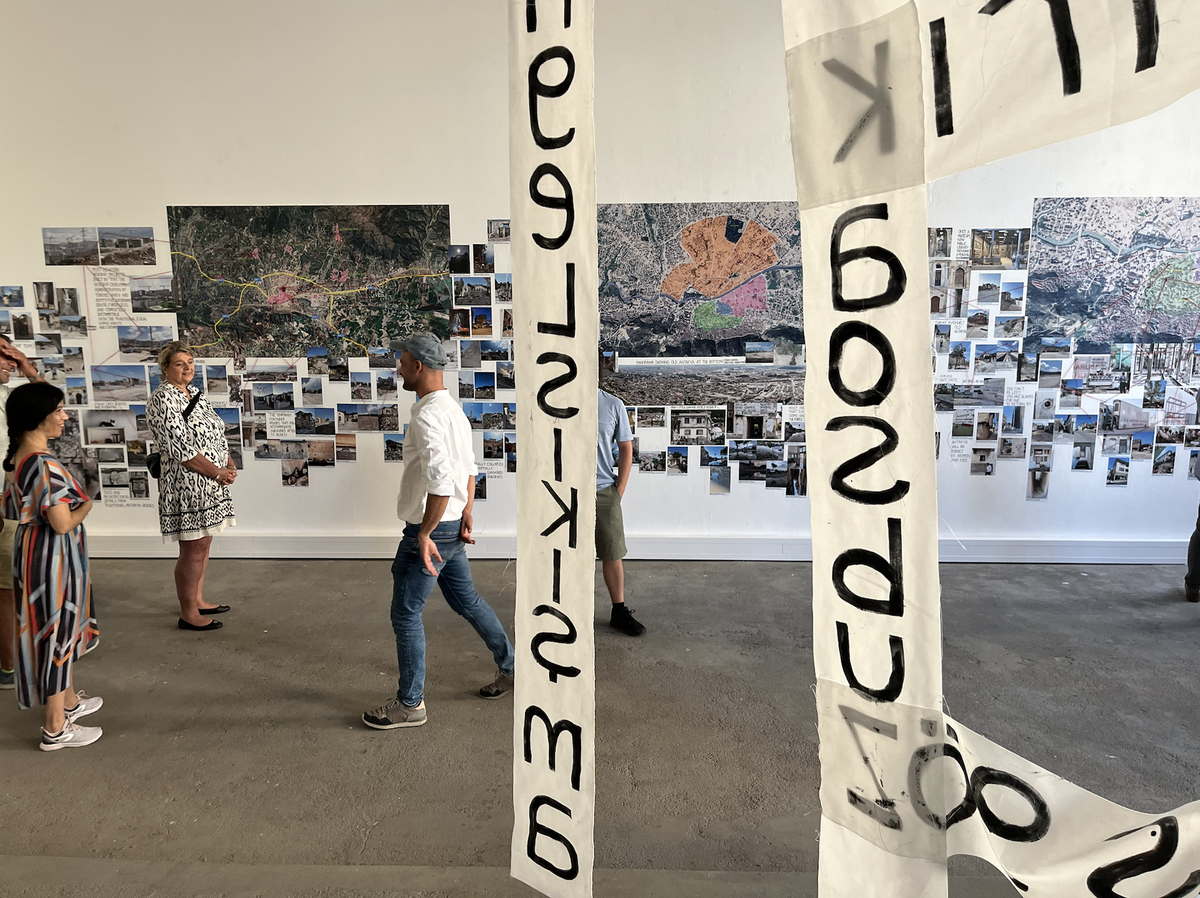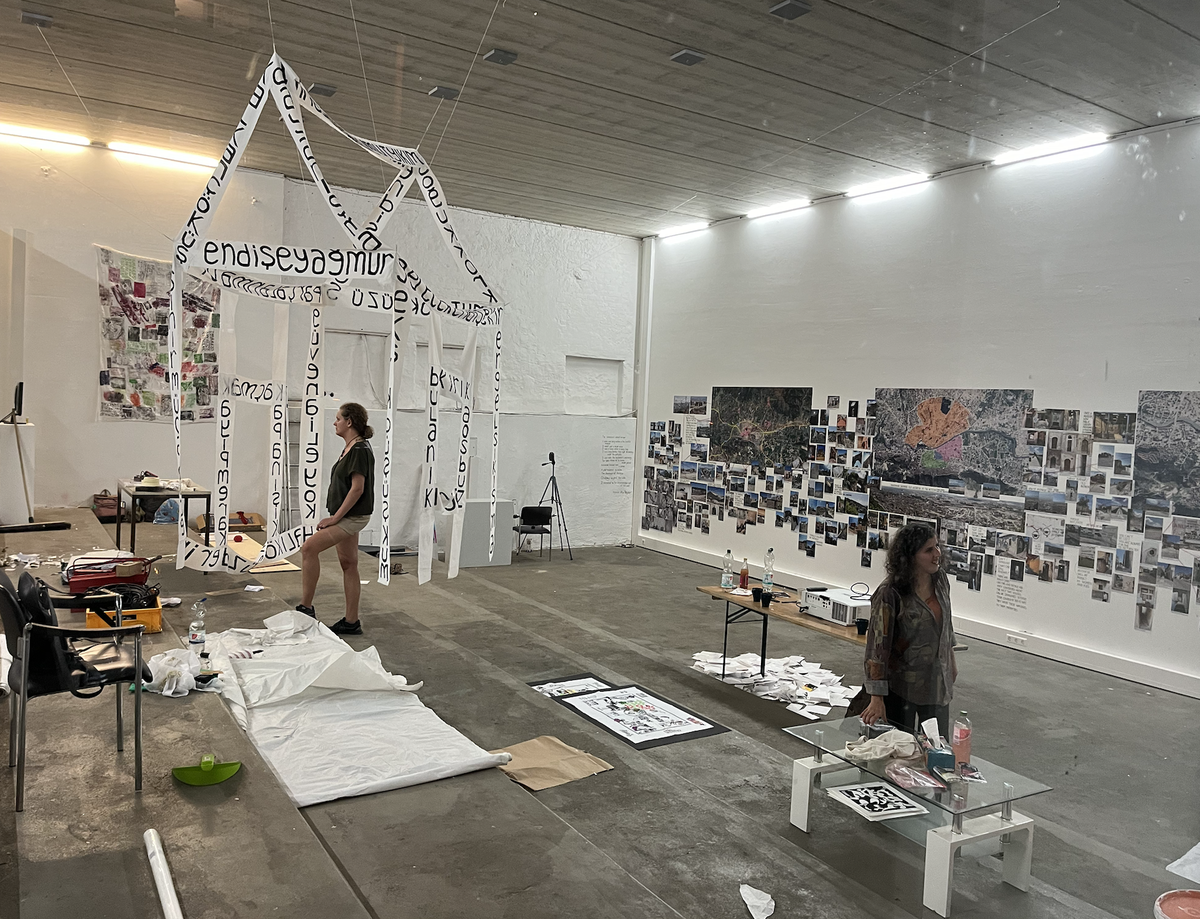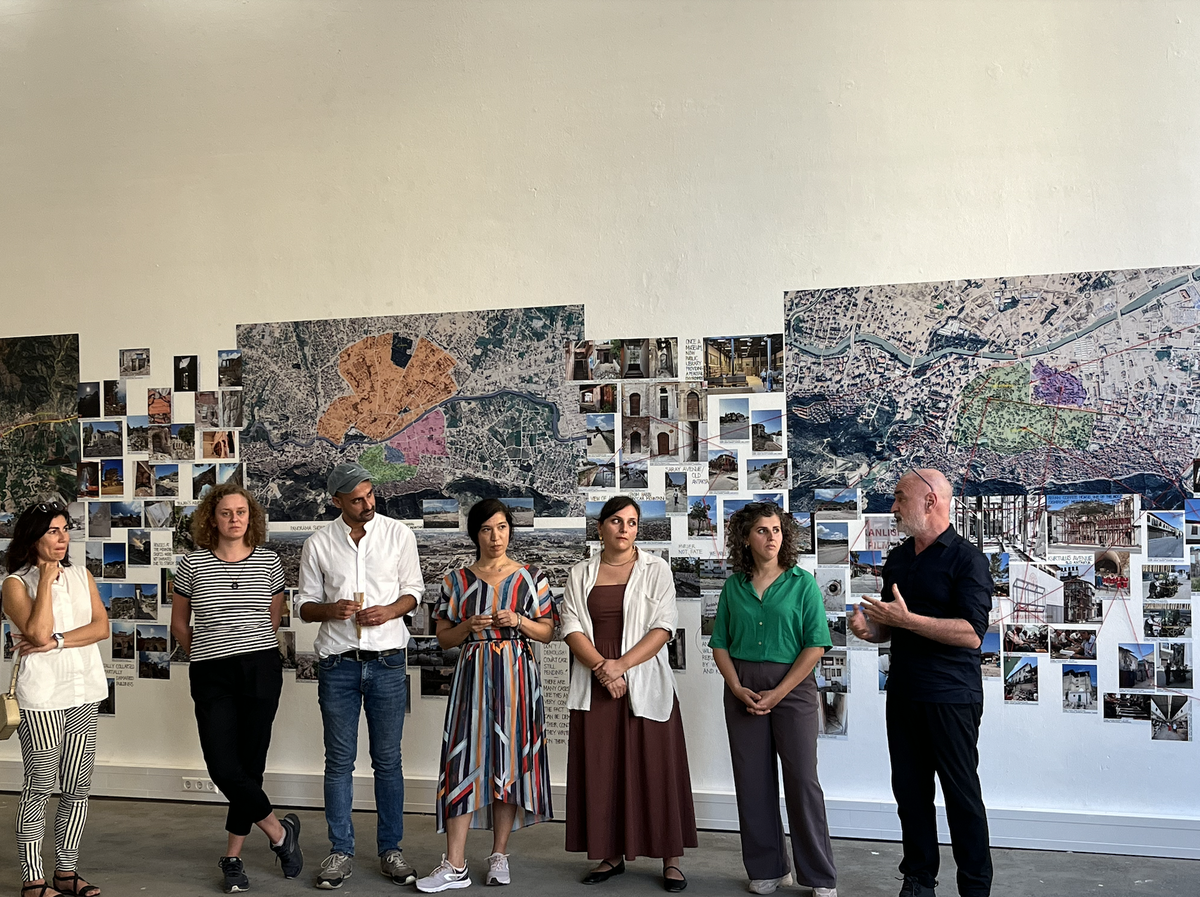An exhibition focusing on Antakya after the earthquake: Art at the Zero Point


On February 6, 2023, earthquakes felt in 11 provinces affected Antakya the most. A year and a half after the earthquakes, most of the city is still living in container cities and lacking basic needs such as water and food. Art at the Zero Point, formed by a group of artists, most of whom are from Antakya, opened an exhibition on the damage caused by the earthquakes in Antakya and the current state of the city. The exhibition, hosted by Gallery KUB in Leipzig, Saxony, Germany, opened on Saturday, September 7. Murat Germen, Melissa Kurtuluş, Emrah Gökdemir, Macide Yalçınkaya, Anastasia Kurtuluş, Sedef Arık, Aslı Şanlı, Çağla İster, Hatice Yıldız Züreyk, Meryem Yalçınkaya, Kenan & Sefa Nuraydın, Ezgi Aysever, Ayben Kaynar Tanır, Evrim Kavcar, Memed Erdener, Raziye Kubat, Pawel Korbus take part in the exhibition which consists of different disciplines from installation to photography, illustration to video. The exhibition is curated by Emrah Gökdemir, Melisa Kurtuluş and Olga Vostretsova.
We talked about Art at the Zero Point with Murat Germen and Melissa Kurtuluş.
When did you go to the earthquake zone? What was the scene like? What did you do when you first arrived?
Murat Germen: When the 1999 earthquake happened, I guided two separate groups, one Italian and one British, including earthquake experts from the Boğaziçi Kandilli Observatory. At that time, there was a need for language-speaking guides for foreign groups and I guided them on this occasion. These people were very disciplined. Especially those from Germany, they knew very well what to do and how to work.
While I was guiding them, I was taking photos and listening with four ears, trying to understand what they were focusing on, what they wanted to know, what photos they were taking and where they wanted to go. I tell you this because when an earthquake happens, we all think about what we can do. We gave financial aid, but this is not enough; we need to do other things.
 At that time, I said, “I already have experience in this field, why not work on it?” Organizations like the Chamber of Urbanists, Chamber of Architects, Chamber of Surveyors and Chamber of Civil Engineers needed information and data. But on the first day, the third day, the fifth day, I couldn’t find anyone because I wasn’t a search and rescue expert, I was only there to do a crime scene investigation.
At that time, I said, “I already have experience in this field, why not work on it?” Organizations like the Chamber of Urbanists, Chamber of Architects, Chamber of Surveyors and Chamber of Civil Engineers needed information and data. But on the first day, the third day, the fifth day, I couldn’t find anyone because I wasn’t a search and rescue expert, I was only there to do a crime scene investigation.
In the process, I realized that professional cameras don’t have a GPS module. If you don’t remember where you took the photo, you have no way of knowing this information. Fortunately, I found software on cell phones that would capture the GPS route and match it to the photos so that they could be used as evidence. I actually took more than 2,000 photos, most of them with details of columns, beams and rebar. Since unribbed rebar was used in the construction of very old buildings, it played a big role in the damage.
All these details, including the tangled rebar, were very important both architecturally and structurally. Wearing white suits and working like CSI investigators, I took photos and documented them so that others could use them. Then I uploaded these photos to Google Drive and made them publicly available, and really a lot of people benefited. I was contacted by surveyors, urbanists, architects and even lawyers. A few lawyers wanted to use these photos to prove damage to buildings.
When did you leave?
M.G.: 10 days after the earthquake. School was starting and the second earthquake, the 6.4 and 5.8 earthquake on Hatay, happened. I was in Hatay at the time. We were shaken and they said that this earthquake was 1% of the strength of the main earthquake. And yet, even that was so frightening that I couldn’t even imagine the power of the main earthquake.
None of the photographs in this exhibition were taken during that 10-day period. The photographs from that period are not here. Because I felt that the work, I produced during that period was useful to someone. Normally I’m a bit of a hardliner, but this time I took quite a risk. I was constantly looking into the unknown; I was looking at plane tickets, bus schedules, groups, but I couldn’t get involved in any of them. Finally, one day, on the 16th, I found a one-way Adıyaman ticket from Pegasus and I said “Oh, God!”. I had no idea what was going to happen, it was a completely spontaneous journey.
People who saw these works started to offer me collaborations. They suggested that I take part in a program called Art at the Zero Point. Evrim was someone I knew from the Mardin Biennial and she recommended me to this art team. When she first wrote to me, I immediately accepted. I said, “What do you mean? I’d love to!” I didn’t have a big goal of healing through art, but I was very interested in being part of an effort through art.
Then we contacted the team and set a date. At that time, I suggested a provocative title, “What do Antakya and Antakya people want?” because there is a master plan being made in Antakya right now, with famous names like Norman Foster and leading architects in Turkey. I also questioned this work and some people got angry with me. Much has been written and drawn about Antakya, but I wondered if enough Antakya people had been consulted. I was asking questions like, “It is impossible to completely bring back the past of Antakya, so where can it be taken?”
So, we did a brainstorming session under the title “What does Antakya want?” We took a board, pasted papers on it, asked everyone’s opinions and wrote them down. Then we did fieldwork for two days. This process was very productive because Antakya people showed us where we should go. All of the work is based on this process. I only have 20-30 photographs, but there are 350 photographs in total and they all belong to the participants. In this sense, we wanted to create a collective memory and we aimed for it to be an important tool in the reconstruction of Antakya.
You wrote a poem alongside your work as a crime scene investigator. Can you tell us the story of that poem?
M.G.: It’s Dilge Can’s poem. Melissa showed it to me and I said, “It’s very well written.” And it was written by someone from Antakya. I said, we should definitely include it.
In the meantime, we need to say something like, “What does Antakya want?” It is natural that I would want to say something about that. But of course, I will be speaking on their behalf and summarizing. As far as I understand, one of the most important things in Antakya is the places where people come together. Because there are a common culture and people can stand side by side very well. That’s why these places are very important. When we interview them, for example, they think that these places should be restored as a matter of urgency and priority. If restoration is not possible, something like on-site renovation should be done there. For example, there are good examples like Cemil Meriç Library. This building, which used to be a museum, has now been turned into a library. It is cool in the summer; people come together in peace and connect to the internet. This place is like an oasis. We talked about the importance of these places.
Another place that stays in my mind is Uzun Çarşı. It emerged as one of the most important places. For example, we have a study on the Uzun Çarşı in one corner. In our first meeting, there was a rumor about the Long Bazaar: “They will demolish it completely and rebuild it.” Therefore, there was an air of panic. We worked there as a case study and talked about it. We came up with many topics and evaluated them. Over time, we started to be given information about what to do with some parts. But we still haven’t been given information about some parts.
The importance of the Uzun Çarşı emerged especially after the earthquake. There are very few places left in the center where we can connect with life. When you go in there, it gives people strength to feel connected to life again, to see that there is still something there. This is something that increases their resilience to life. That’s why Uzun Çarşı has become a very valuable working space for us. Of course, it won’t be the same, but these places are still very important.
At this point I would like to ask: Healing through art may be possible in many cases, but something very different happened here. Murat Bey is not from Antakya, but you are. How would you describe the expression of healing through art on this exhibition or on Antakya?
Melissa Kurtuluş: The word healing sounds very pretentious to me too. Because I think it is a concept that many people use in this process, but I think it is a bit eviscerated. Actually, this is how I see healing: togetherness. Art both opens a space for expression and offers a way to re-establish this togetherness. We had such moments that we remembered that sense of togetherness that we had forgotten. There were such moments that we could laugh, laugh or express ourselves in different ways as if nothing had happened. We received feedback from people about this. Another form of expression, instead of experiencing pain or grief in the usual ways, it is possible to use it as a tool to transform it. This is how I look at healing.
At first, we were using the word ‘healing’ but in order to heal, we need to heal ourselves first. So, how do we heal? We will do what we love, what we know and what we like to do together by coming together, telling each other, being influenced by each other’s talents. After this healing process, maybe if we can set an example for other people, we will take a small step towards healing by saying ‘Look what beautiful things they have done’.
What my teacher Murat said was actually our starting point. At first, before applying to the meetings, we were thinking, “Should we apply or not?” We were all traumatized, it had only been three or four months. This is how the process started. Then we received motivation from people around us like, “This will be good for you too.” So, we decided to start the way we know best. As my teacher Murat said, our aim was to heal ourselves first, to be together and then to spread it.
Everyone who is human was affected by this event. But there is no doubt that for someone who was born and raised there or who has family there, the situation has a different dimension. You said, ‘3-4 months later we were still traumatized’. When you decide to do something about this event, you first have to accept it, digest it, face it, do something about it, deal with the trauma.
M.G: That’s exactly what I was talking about, I can’t really talk about trauma. I was very affected, yes, but it seems a bit exaggerated for me to even consider my own experiences as trauma compared to what happened. I had seen the 1999 earthquake, but this was a much bigger destruction. I have never encountered such destruction in my life. But I am still ashamed to talk about trauma, because there has been so much suffering in the region, who cares about my trauma?
 But I also want to say this; I think we have created something beautiful here; and we should continue, the continuity of this work is very important. We worked together and came up with something. We discovered different forms of expression, methods of documentation, ways of not forgetting and creating memory. We will continue to follow what will happen in the next process. For example, how will the TOKİ projects proceed? There is also uncertainty about what Antakya wants. Where will people settle? If they will go to TOKİ, which TOKİ will they go to? Which apartment in TOKİ will they live in? Nobody knows anything, they are not telling anyone anything. How will someone who has a shop in Uzun Çarşı go back there? If you are not a tenant, what kind of ownership transfer will they offer you? The shops were already small, will they give you a smaller one?
But I also want to say this; I think we have created something beautiful here; and we should continue, the continuity of this work is very important. We worked together and came up with something. We discovered different forms of expression, methods of documentation, ways of not forgetting and creating memory. We will continue to follow what will happen in the next process. For example, how will the TOKİ projects proceed? There is also uncertainty about what Antakya wants. Where will people settle? If they will go to TOKİ, which TOKİ will they go to? Which apartment in TOKİ will they live in? Nobody knows anything, they are not telling anyone anything. How will someone who has a shop in Uzun Çarşı go back there? If you are not a tenant, what kind of ownership transfer will they offer you? The shops were already small, will they give you a smaller one?
A similar situation applies to houses. If you have a 100 square meter house or a 3+1 apartment, it is said that earthquake victims will mostly be given smaller apartments. This is what happened in Istanbul. Earthquake victims were given smaller apartments and people saw the renovation of their houses as a great investment. But even in Istanbul, where land values were high, instead of 120-130 square meter houses, 90 square meter apartments were given. The same will happen here. Erdoğan himself announced that if you want the house to be the same size as before, you will have to pay for it. This is one of the despicable tricks of capitalism. There is a saying “half of it is on us”, but this is a complete illusion. It looks like they are doing a favor, but in fact they will make the homeowners pay for even half. I was already a landlord; you can’t tell me “Half is on us”. It’s a completely misleading game.
M.K.: Yes, for us it was a difficult decision. We were all in a really traumatic situation. But on the other hand, that summer, we were in the process of accepting the situation. It was like a grieving process. You lose someone and you have to face it. The loss of thousands of people, the destruction of schools, homes, the streets you walk on... It was a huge grieving process.
I took care of my family’s needs, then I focused on the project. But in the end, I realized that I had feelings that I needed to face and transform.
Do you think you were running away from your own grief?
M.K.: It was like a reflexive rush for us because it was like an emergency; I can’t think of the right word, but it was instinctive. Yes, the problems don’t end; you have to do certain things and it’s like an obligation. After a certain point, it can also be a psychological urge to escape, but that’s not the only thing; there are obligations and you don’t have time for personal mourning. But in the moments when I stopped, in the waiting periods, I experienced that mourning process. I was constantly moving between three cities for a year: Antalya, Adana and Antakya. I moved my family to Antalya; I was on a route between these three cities. I also went to other places I needed to go, but these three cities were a continuous cycle. That’s how we lived the summer. We also had constant online meetings as a team, which turned into a group therapy. There were moments when we cried together while writing the project. We reflected our emotions while generating the ideas. That’s why we tried to choose our guest artists among people who had a connection to Antakya. There was a feeling that someone who had never seen Antakya would not understand us. We met with people who had those connections, and that’s how we connected with Murat Germen. Every work transformed something in some way.
Will the exhibition move to Turkey?
M.K.: Yes. There will definitely be an exhibition in Antakya. Since Galerie KUB’s exhibition dates are in September, we prepared this exhibition quickly. Our workshop ended on August 26th and we started the exhibition right after. The exhibition will then be in Istanbul and Antakya. For Istanbul, there is a possibility that the exhibition will be at DEPO, but this is not yet finalized. The exhibition in Antakya will be held in October, and then there may be an exhibition in Istanbul. This will be finalized in October.


